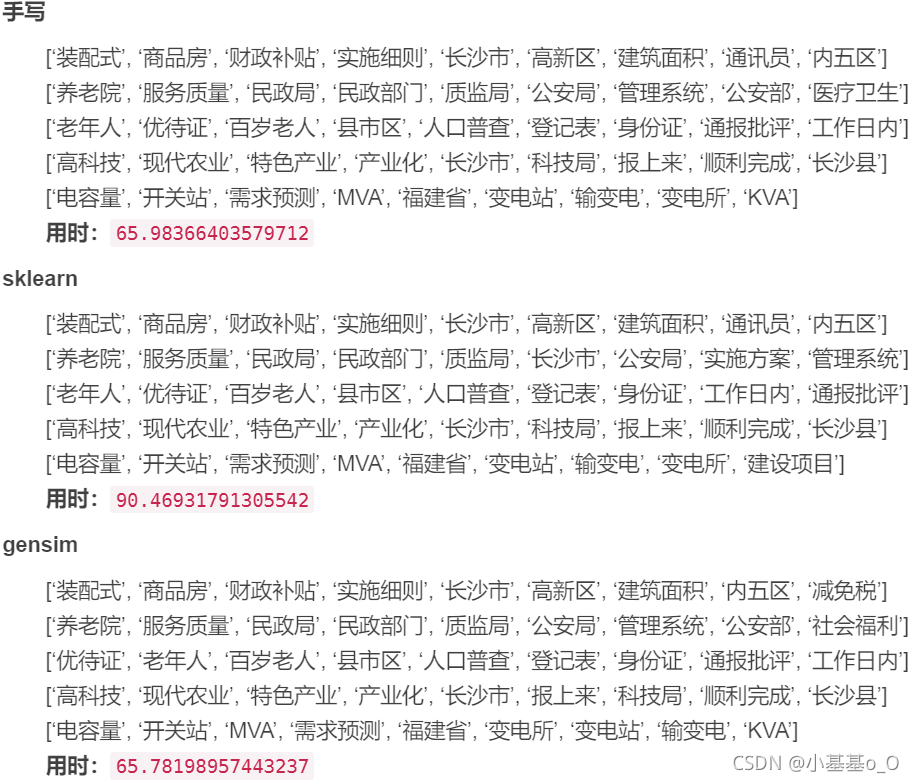原理
TF(Term Frequency):词频
T F = 该 词 频 数 文 档 词 语 总 数 TF = \frac{该词频数}{文档词语总数} TF=文档词语总数该词频数
IDF(Inverse Document Frequency):逆文本频率指数
I D F = log ( 文 档 总 数 出 现 该 词 文 档 数 + 1 ) IDF = \log(\frac{文档总数}{出现该词文档数+1}) IDF=log(出现该词文档数+1文档总数)
调用jieba(免训练)
from jieba.analyse import tfidf
sentence = '佛山市科技局发布关于发展佛山市人工智能项目的通知'
print(tfidf(sentence))
print(tfidf(sentence, allowPOS=('n', 'ns', 'v', 'vn'))) # 按词性筛选
print(tfidf(sentence, allowPOS=('n', 'ns', 'v', 'vn'), withFlag=True)) # 返回词性
print(tfidf(sentence, withWeight=True)) # 返回权重
打印结果
['佛山市', '科技局', '人工智能', '通知', '发布', '关于', '项目', '发展']
['佛山市', '科技局', '人工智能', '通知', '发布', '项目', '发展']
[pair('佛山市', 'ns'), pair('科技局', 'n'), pair('人工智能', 'n'), pair('通知', 'v'), pair('发布', 'v'), pair('项目', 'n'), pair('发展', 'vn')]
[('佛山市', 2.2638012411777777), ('科技局', 1.3454353536333334), ('人工智能', 1.0508918217211112), ('通知', 0.6714233436266667), ('发布', 0.5657954481322222), ('关于', 0.5532763439699999), ('项目', 0.5425367102355555), ('发展', 0.39722939449333333)]
Python手写
from collections import Counter
from math import log10
from re import split
from jieba.posseg import dt
FLAGS = set('a an b f i j l n nr nrfg nrt ns nt nz s t v vi vn z eng'.split())
def cut(text):
for sentence in split('[^a-zA-Z0-9\u4e00-\u9fa5]+', text.strip()):
for w in dt.cut(sentence):
if len(w.word) > 1 and w.flag in FLAGS:
yield w.word
class TFIDF:
def __init__(self):
self.idf = None
self.idf_max = None
def fit(self, texts):
texts = [set(cut(text)) for text in texts]
lent = len(texts)
words = set(w for t in texts for w in t)
self.idf = {w: log10(lent/(sum((w in t)for t in texts)+1)) for w in words}
self.idf_max = log10(lent)
return self
def get_idf(self, word):
return self.idf.get(word, self.idf_max)
def extract(self, text, top_n=10):
counter = Counter()
for w in cut(text):
counter[w] += self.get_idf(w)
return [i[0] for i in counter.most_common(top_n)]
tfidf = TFIDF().fit(['奶茶', '巧克力奶茶', '巧克力酸奶', '巧克力', '巧克力']*2)
print(tfidf.extract('酸奶巧克力奶茶'))
sklearn
from re import split
from jieba.posseg import dt
from sklearn.feature_extraction.text import TfidfVectorizer
from collections import Counter
FLAGS = set('a an b f i j l n nr nrfg nrt ns nt nz s t v vi vn z eng'.split())
def cut(text):
for sentence in split('[^a-zA-Z0-9\u4e00-\u9fa5]+', text.strip()):
for w in dt.cut(sentence):
if len(w.word) > 2 and w.flag in FLAGS:
yield w.word
class TFIDF:
def __init__(self, idf):
self.idf = idf
@classmethod
def train(cls, texts):
model = TfidfVectorizer(tokenizer=cut)
model.fit(texts)
idf = {w: model.idf_[i] for w, i in model.vocabulary_.items()}
return cls(idf)
def get_idf(self, word):
return self.idf.get(word, max(self.idf.values()))
def extract(self, text, top_n=10):
counter = Counter()
for w in cut(text):
counter[w] += self.get_idf(w)
return [i[0] for i in counter.most_common(top_n)]
gensim
from gensim.corpora import Dictionary
from gensim.models import TfidfModel
from re import split
from jieba.posseg import dt
FLAGS = set('a an b f i j l n nr nrfg nrt ns nt nz s t v vi vn z eng'.split())
def lcut(text):
return [
w.word for sentence in split('[^a-zA-Z0-9\u4e00-\u9fa5]+', text.strip())
for w in dt.cut(sentence)if len(w.word) > 2 and w.flag in FLAGS]
class TFIDF:
def __init__(self, dictionary, model):
self.model = model
self.doc2bow = dictionary.doc2bow
self.id2word = {i: w for w, i in dictionary.token2id.items()}
@classmethod
def train(cls, texts):
texts = [lcut(text) for text in texts]
dictionary = Dictionary(texts)
corpus = [dictionary.doc2bow(text) for text in texts]
model = TfidfModel(corpus)
return cls(dictionary, model)
def extract(self, text, top_n=10):
vector = self.doc2bow(lcut(text))
key_words = sorted(self.model[vector], key=lambda x: x[1], reverse=True)
return [self.id2word[i] for i, j in key_words][:top_n]
手写、sklearn、gensim结果比较
from time import time
t0 = time()
with open('policy.txt', encoding='utf-8')as f:
_texts = f.read().strip().split('\n\n')
tfidf = TFIDF.train(_texts)
for _text in _texts:
print(tfidf.extract(_text))
print(time() - t0)
结果打印:
速度:手写≈gensim>sklearn
关键词:三者Top2完全相同,之后不完全相同























 1818
1818











 被折叠的 条评论
为什么被折叠?
被折叠的 条评论
为什么被折叠?










